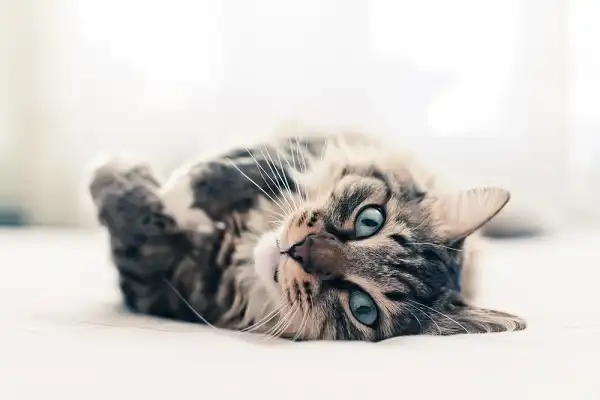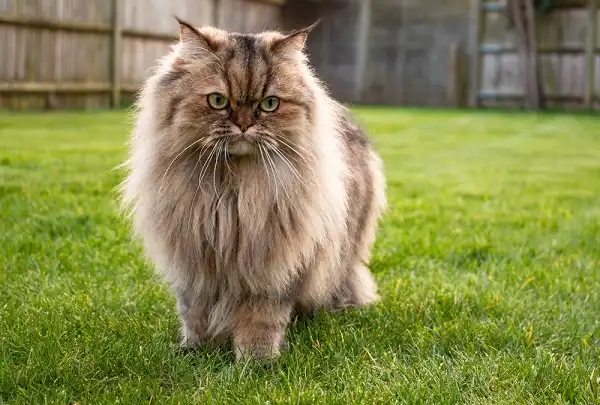If you find yourself unable to resist the charm of furry felines, then this blog post is perfect for you! Whether you’re a wild and curious cat person or just an admirer of their independence from daily obligations, learning about cats can be a fun adventure. From their unique biology and behavior to famous breeds, there’s no shortage of engaging facts that shed light on these majestic creatures – prepare yourself for a fascinating journey into the world of cats!

Cat Description
Cats are unique creatures with an unmistakable look and demeanor. With their long, slender bodies, silky fur, and large, tufted ears, cats have a distinct silhouette that stands out among other pets. They come in all shapes and sizes, from the petite Devon Rex to the towering Maine Coon. No matter the breed or size, though, every cat has some key physical traits in common—including a flexible spine for nimble stretching and jumping abilities, retractable claws to help them climb trees and hunt prey more effectively, plus sharp teeth designed for shredding meat. Cats also stand out for their wide range of colors and patterns. Although certain breeds are known to have certain coat colors (such as Siamese cats being usually gray-blue), most cats have combinations of two or more colors such as white with tabby stripes or black with white patches. Along with their fur coats come other notable features like fluffy tails or spiky manes. Each cat’s physical characteristics give it its own unique look and personality, making them one of the most intriguing animals around!
Cat Habitat
Cats are found all over the world, from the sweltering deserts of the Middle East to the frozen tundra of Siberia. They can live in a variety of habitats, from towns and cities to grasslands and forests. As long as their environment has food, shelter, and enough space for them to explore and roam, cats can thrive in almost any ecosystem. Wild cats typically find shelter in dens or caves where they can snuggle up with other family members for warmth. In areas with more extreme temperatures or seasonal changes like summer heat or winter snowfall, cats will often seek shelter in hollow trees, haystacks, abandoned buildings, barns, and other man-made structures. Finally, it’s important for cats to have access to water sources so they can stay hydrated during hot days or times when prey is scarce. Cats don’t need large bodies of water like lakes or oceans – any shallow puddle will do! So if you spot a wild cat lapping up some rainwater off a sidewalk puddle after a stormy day, there’s no need for alarm – he’s just making sure he’ll stay healthy throughout his next adventure!
Cat Diet
Cats are obligate carnivores, meaning that they must consume meat to survive. In the wild, cats feed on small prey such as birds, rodents, and reptiles. Domesticated cats tend to eat a diet of wet and dry cat food, which contains mainly proteins derived from fish or poultry. However, cats can also benefit from a variety of healthy snacks like cooked eggs or lean meats. Cats’ digestive systems are designed to extract the maximum amount of nutrients from their food sources in order to meet their high energy demands. Therefore, it is important for cats to have access to a balanced diet that contains all of the necessary macronutrients (fat, protein, and carbohydrates) and micronutrients (vitamins and minerals).
Cats require large amounts of protein in their diets – up to 30% in some cases – as it helps build muscle mass and keep them fit and energetic. Protein-rich foods like fish, chicken, beef, and turkey are great sources for cats. They also need dietary fat for energy production and insulation against heat loss; fatty acids like omega-3 can be found in seafood such as salmon or tuna. Additionally, carbohydrates provide essential energy for daily activities while fiber helps support digestion by promoting healthy bowel movements. Cats should receive roughly 10-15% of their daily calories from carbohydrates (such as oats or wheat), but this percentage may vary depending on the individual pet’s lifestyle.

Cat Size
The average size of a cat varies greatly depending on its breed and sex. Domestic cats range from as small as 2 to 3 pounds, for smaller breeds like the Singapura, to as large as 20 pounds for larger breeds such as the Maine Coon. The average height at the shoulders is usually between 8 and 10 inches for most domesticated cats, although larger breeds may reach up to 12 inches in height. Among the smallest cats are the Singapura and Munchkin breeds, both of which typically weigh only 4-7 pounds and measure just 6-8” tall at the shoulder. On the other end of the spectrum are larger cats such as Maine Coons and Ragdolls which can weigh up to 18-20 pounds and reach heights of 11-12” at the shoulder. Large male cats may even exceed this size range if they have been well-fed!
Cat Lifespan
Cat lifespan can vary widely depending on breed, health, and environmental factors. Generally speaking, cats can live anywhere from 12 to 20 years. Smaller breeds tend to have longer lifespans than larger breeds due to their size and metabolism rate. In addition, cats with good diets and plenty of exercise are likely to live longer than those who do not receive proper nutrition or have an inactive lifestyle. Cats’ average lifespans may differ based on other factors as well. For instance, indoor cats tend to live longer than outdoor cats due to their reduced exposure to environmental risks like parasites or predators. Similarly, cats living in colder climates tend to have shorter lifespans since they have increased energy needs in order to remain warm during cold winter days. Finally, it is important for cat owners to ensure that their pet receives regular veterinary checkups in order for illnesses or diseases that could shorten their lifespan can be detected as early as possible. With proper care and attention, cats can live happy and healthy lives up until the very end!
Cat Behavior
Cats are curious and intelligent creatures that display a wide variety of behaviors. Domestic cats often form strong attachments to their owners, greeting them with meows and purrs when they come home from work. They also engage in activities like play-fighting, chasing toys, or stalking prey in the house. Much of a cat’s behavior is instinctive—they will instinctively scratch objects in order to sharpen their claws or mark their territory with scent glands located on their faces and paws. Cats are also highly territorial animals that may become aggressive when faced with intruders or unfamiliar cats in their environment.
Cats use various forms of communication in order to interact with each other and express themselves. Meow, purr, yowl, hiss, growl, snarl—all these noises have different meanings and can indicate pleasure, anxiety, fear, or aggression. Some cats even make chirping sounds similar to that of a bird when they’re excited! Cats use body language to communicate as well—tails held high indicate happiness while an arched back can be an expression of fear or aggression. Similarly, cats may rub their cheeks against furniture or people to show affection or mark their scent onto surfaces as a way of claiming it as part of their territory.

Cat Speed
Cats are known for their lightning-quick reflexes and agility, which allows them to catch their prey with ease. The average cat can reach speeds of up to 30 miles per hour in just a few seconds and can cover a distance of 100 feet in just 6 seconds. This incredible speed is possible thanks to their lightweight bodies and powerful hind legs, which give them the ability to launch themselves forward at high speeds. When cats are running, they typically move in a bounding pattern with four feet coming off the ground at one time—this helps them maintain their balance better than if they ran on 2 feet only.
When chasing after prey, cats can reach top speeds of up to 50 miles per hour over short distances; however, this type of sprinting requires high levels of energy and cats cannot sustain these speeds for long periods of time. In addition to speed, cats have fantastic dexterity and can make sharp turns without losing much momentum. When chasing after prey, cats often use a technique called zig-zagging which involves making sudden changes in direction that deceive their quarry and force it into submission. These lightning-fast reflexes also come in handy when defending against predators or scaling tall objects such as trees or fences.
Cat Hunting
Cat hunting is a fascinating display of a cat’s intelligence and agility. Cats are natural predators, and they use a variety of techniques to catch their prey. They typically stalk their quarry silently, waiting for the perfect moment to pounce. When they do attack, they will often use their sharp claws to snag their target before ripping into it with powerful jaws. Cats also employ clever tactics such as zig-zagging or changing direction suddenly in order to disorient their prey and force them into submission. Cats are also able to leap up on tall objects such as trees or fences in order to reach birds or other small animals that may be out of reach. In addition to using physical speed and agility, cats also rely on stealthy tactics such as hiding in tall grasses or in the shadows of buildings in order to ambush their prey undetected. They have keen eyesight which allows them to spot potential meals from far away and they possess an acute sense of hearing that enables them to pick up on even the slightest sound made by smaller animals scurrying around nearby.

Conclusion
Cats are incredibly versatile creatures capable of forming strong bonds with humans and displaying complex behaviors. They possess amazing physical attributes such as speed, dexterity, and agility which allow them to hunt prey efficiently in the wild or at home. In addition to their physical prowess, cats also use a variety of vocalizations and body language in order to communicate their feelings to those around them. With patience and understanding from their owners, cats can thrive in almost any environment! Overall, cats make excellent companions who will always surprise us with their intelligence and grace. Additionally, they are sure to keep us entertained with their unique personalities!
Frequently Asked Question

